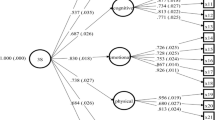Abstract
We extended research on the construct validity of overall and life facet satisfaction measures by (a) estimating relations among satisfaction constructs disattenuated for measurement error, and (b) controlling for spurious effects of common method variance, using confirmatory factor analysis (CFA) of multitrait-multimethod (MTMM) data. Results indicated strong support for convergent and discriminant validity, as well as for significant method effects. Results also indicated that corrected correlations among latent satisfaction variables were similar to their observed counterparts, suggesting that the attenuating effects of measurement error tend to balance spuriousness interjected by common method variance. Suggestions for future research include determining boundary variables which influence the direction of the relationship between overall and life facet satisfaction, and for identifying subgroups of individuals within which these relationships are homogeneous.
Similar content being viewed by others
References
Andrews, F. M. and Withey, S. B.: 1974, ‘Developing measures of perceived life quality: Results from several national surveys’, Social Indicators Research 3, pp. 1–19.
Andrews, F. M. and Withey, S. B.: 1976, Social Indicators of Well-Being: Americans' Perceptions of Life Quality (Plenum, New York).
Bagozzi, R. P. and Yi, Y.: 1990, ‘Assessing method variance in multitrait-multimethod matrices: The case of self-reported affect and perceptions at work’, Journal of Applied Psychology 75, pp, 547–560.
Bentler, P. M. and Bonett, D. G.: 1980, ‘Significance tests and goodness-of-fit in the analysis of covariance structures’, Psychological Bulletin 88, pp. 588–606.
Bentler, P. M. and Woodward, J. A.: 1983, ‘The greatest lower bound to reliability’, in H. Wainer and S. Messick (eds.), Principals of Modern Psychological Measurement (Erlbaum, Hillsdale, NJ), pp. 237–253.
Blalock, H. M. Jr.: 1969, ‘Multiple indicators and the causal approach to measurement error’, American Journal of Sociology 75, pp. 264–271.
Campbell, A., Converse, P. E. and Rogers, W. L.: 1976, The Quality of American Life: Perceptions, Evaluations, and Satisfactions (Russell Sage Foundation, New York).
Campbell, D. T. and Fiske, D. W.: 1959, ‘Convergent and discriminant validation by the multitrait-multimethod matrix’, Psychological Bulletin 56, pp.81–105.
Costner, H. L.: 1969, ‘Theory, deduction, and rules of correspondence’, American Journal of Sociology 75, pp. 245–263.
Diener, E.: 1984, ‘Subjective well-being’, Psychological Bulletin 95, pp. 542–575.
Diener, E., Sandvik, E., Pavot, W. and Gallagher, D.: 1991, ‘Response artifacts in the measurement of subjective well-being’, Social Indicators Research 24, pp. 35–56.
Feldt, L. S. and Brennan, R. L.: 1989, ‘Reliability’, in R. L. Linn (ed.), Educational Measurement (3rd. ed.) (Macmillan, New York), pp. 105–146.
Glatzer, W. and Mohr, H-M.: 1987, ‘Quality of Life: Concepts and Measurement’, Social Indicators Research 19, pp. 15–24.
Guion, R. M.: 1965, Personnel Testing (McGraw-Hill, New York).
Heady, B., Holmstrom, E. and Wearing, A.: 1985, ‘Models of well-being and ill-being’, Social Indicators Research 17, pp. 211–234.
Heady, B., Veenhoven, R. and Wearing, A.: 1991, ‘Top-down versus bottom-up theories of subjective well-being’, Social Indicators Research 24, pp. 81–100.
James, L. R., Mulaik, S. A. and Brett, J.: 1982, Causal Analysis: Models, Assumptions and Data (Sage, Beverly Hills, CA).
Jöreskog, K. G. and Sörbom, D.: 1986, LISREL-VI: User's Guide (Scientific Software, Mooresvile, IN).
Kunin, T.: 1965, ‘The construction of a new type of attitude scale’, Personnel Psychology 8, pp. 65–78.
Lance, C. E., Lautenschlager, G. J., Sloan, C. E. and Varca, P. E.: 1989, ‘A comparison between bottom-up, top-down, and bidirectional models of the relationships between global and life facet satisfactions’, Journal of Personality 57, pp. 601–624.
Long, J. S.: 1983, Confirmatory Factor Analysis (Sage, Beverly Hills, CA).
Marsh, H. W., Balla, J. R. and McDonald, R. P.: 1988, ‘Goodness-of-fit in confirmatory factor analysis: The effect of sample size’, Psychological Bulletin 103, pp. 391–410.
Marsh, H. W. and Hocevar, D.: 1983, ‘Confirmatory factor analysis of multitrait-multimethod matrices’, Journal of Educational Measurement 20, pp. 231–248.
Michalos, A. C.: 1985, ‘Multiple discrepancies theory (MDT)’, Social Indicators Research 16, pp. 347–413.
Rain, J. S., Lane, I. M. and Steiner, D. D.: 1991, ‘A current look at the job satisfaction/life satisfaction relationship: Review and future considerations’, Human Relations 44, pp. 287–307.
Rice, R. W., McFarlin, D. B., Hunt, R. G. and Near, J. P.: 1985, ‘Organizational work and the perceived quality of life: Toward a conceptual model’, Academy of Management Review 10, pp. 296–310.
Scarpello, V. and Campbell, J. P.: 1983, ‘Job satisfaction: Are all the parts there?’ Personnel Psychology 36, pp. 577–600.
Schmitt, N. and Stults, D. M.: 1986, ‘Methodology review: Analysis of multitrait-multimethod matrices’, Applied Psychological Measuremen 10, pp. 1–22.
Shaffer, G. S.: 1987, ‘Patterns of work and nonwork satisfaction’, Journal of Applied Psychology 72, pp. 115–124.
Sloan, C. E.: 1990, Relations between Global Life and Domain Satisfaction: The Role of Domain Scope and Criticiality. Unpublished doctoral dissertation (University of Georgia, Athens).
Spector, P.: 1987, ‘Method variance as an artifact in self-reported affect and perceptions at work: Myth or significant problem?’, Journal of Applied Psychology 72, pp. 438–443.
Widaman, K. F.: 1985, ‘Hierarchically nested covariance structure models for multitrait-multimethod data’, Applied Psychological Measurement 9, pp. 1–26.
Williams, L. J., Cote, J. A. and Buckley, M. R.: 1989, ‘Lack of method variance in self-reported affect and perceptions at work: Reality or artifact?’, Journal of Applied Psychology 74, pp. 462–468.
Author information
Authors and Affiliations
Rights and permissions
About this article
Cite this article
Lance, C.E., Sloan, C.E. Relationships between overall and life facet satisfaction: A multitrait-multimethod (MTMM) study. Soc Indic Res 30, 1–15 (1993). https://doi.org/10.1007/BF01080329
Accepted:
Issue Date:
DOI: https://doi.org/10.1007/BF01080329




